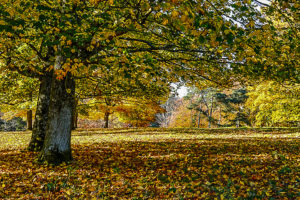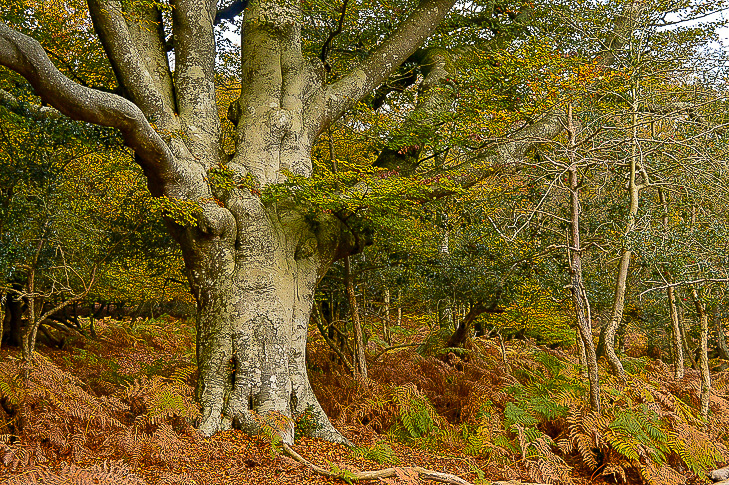 When we think of Woodland, for many one place immediately springs to mind. The New Forest remains one of the very few places in England where the ancient landscape has been changed very little by modern day society.
When we think of Woodland, for many one place immediately springs to mind. The New Forest remains one of the very few places in England where the ancient landscape has been changed very little by modern day society.
Vast swathes of beautiful woodland and heathland can still be found, even the age old practice of commoning is still very much an aspect of New Forest life today.
It was in 1079 when William The Conqueror came to The New Forest and named the area his ‘new hunting forest’. Over 1,000 years later his ‘Nova Foresta’ still retains the same beauty and mystery that first captivated him.
The trees of the New Forest provide some of the greatest history of the region, some are so ancient they have stood the test of time through centuries gone by. There are many different tree species that can be found throughout the Forest, these include mighty redwoods, beech, oaks, yew, holly and plenty more.
The ancient system established by William The Conqueror to manage and protect the woodland and heathland is still in place today. The collective efforts of the Verderers, Agisters and Commoners, the judges, stockmen and land users of the forest have continually supported this system and have ensured it has been upheld to the present day.
It has been claimed by the New Forest National Park Association that the New Forest is believed to have the highest concentration of ancient trees in Western Europe.

Ancient and Ornamental Woodland
To use the term ‘Ancient and Ornamental Woodlands’ means a reference to the many areas of the New Forest that incorporate a blend of native trees and bushes, such as beech, oak and holly.
The size of these woodlands vary and many are unenclosed. Huge areas have changed very little and remain completely natural since the time of King William I and his deer hunting trips into the Forest. In fact one of his particular strict Forest Laws prevented the local inhabitants of the New Forest, or ‘commoners’ as they were known back then, from interfering with the vegetation. They were only permitted to some basic firewood collecting rights. This law guaranteed that good cover and food was retained for the wild animals of the Forest, deer most notably.
The Ancient and Ornamental Woodlands of the New Forest have also been influenced by industries of the past. One of the biggest areas of influence was the use of broadleaf trees such as beech and oak. They were used by the Royal Navy for ship building in the second half of the 18th century and Nelson’s favourite ship, HMS Agamemnon, was built at Bucklers Hard using New Forest timber. This vessel then went on to see action in the Battle of Trafalgar.
The Mighty Oak
Many of the oak trees that can be seen on our current landscapes would have been planted to replace those cut down by the Navy and to be potentially used as future stocks. It was the subsequent development of iron clad ships and the associated redundancy of oak in the ship building industry that has ensured these magnificent native trees have survived and continue to grow today.
Timber had other local uses of course and numerous small areas within the Ancient and Ornamental Woodlands were separated and enclosed with a ditch, bank and small timber fence. The idea was to keep the animals out and so inhibit grazing and the associated damage to the vegetation.
The enclosed trees within the segregated areas were usually coppiced and cut at ground level. This promoted rapid growth of new stems. Employing this ingenious method of tree management greatly increased the amount of timber per tree, which ensured a plentiful supply for local use.
Moving through time to the present day, the Ancient and Ornamental Woodlands of the New Forest now provide the perfect setting for a great walk and amazing opportunities to spot the wildlife. On foot, there are no restrictions on where you can or cannot go through these beautiful woodlands. This is an ideal way to experience the unique atmosphere of these ancient woods.
The animals grazing throughout the Forest for centuries has resulted in a distinct pattern within these woodlands. There are wonderful combinations of open glades mixed with dense undergrowth and tall mature trees mixed with holly bushes and bracken.
The native animals, such as the New Forest ponies and deer are able to roam freely throughout the woodlands with few restrictions and away from the more popular places, the wildlife can be found in abundance within the Ancient and Ornamental Woodland of the New Forest.

Bolderwood Ornamental Drive
The awesome Knightwood Oak is also known as the ‘Queen of the Forest’ and is estimated to be over 500 years old. This mighty tree can be found approximately 2.4 miles from Lyndhurst on the Bolderwood Ornamental Drive and is a beautiful sight to see throughout the year.
Bolderwood Ornamental Drive, also known as Bolderwood Arboretum is also a fantastic place to observe ornamental coniferous trees, which were planted in 1860. It is also home to the Bolderwood Deer Sanctuary, the beautiful trees and wildlife that can be found here make it a perfect day out and provides great photo opportunities.
Rhinefield Ornamental Drive
Located between Brockenhurst and the busy A35 is Rhinefield Ornamental Drive. This delightful narrow tree lined road offers a mixture of large rhododendrons, azaleas and some very tall trees.
The best time to visit is in late May and early June with the rhododendrons and azaleas in flower, this is very popular throughout the year and attracts a large number of visitors.
The southern end of Rhinefield Ornamental Drive features a sharp bend at the entrance to the impressive Rhinefield House. At one time it was a private country mansion but is now a hotel. The house was constructed in the second half of the nineteenth century and boasts a huge garden with ornamental ponds. The idyllic setting amidst a stunning woodland backdrop makes it the perfect place for a wedding or short break.
At the time this amazing property was being built, many non-native trees were planted along the track leading to the house. It was predominantly the year 1859 when many of the trees seen along the Ornamental Drive today were planted.

Redwoods & Douglas Firs
Some of the trees that can be seen include giant Redwoods and Douglas firs. It so happens, the two tallest trees within the New Forest are situated here. A pair of spectacular redwoods can be observed standing each side of an open grassy ride. In America, redwoods are known to be up to 3000 years old, so at around 150 years old these two giants of the New Forest National Park are merely youngsters!
Several walks can start and finish from Rhinefield Ornamental Drive, the most popular being the aptly named Tall Trees Trail.
This is a short walk and is suitable for most abilities, about 1 1/2 miles on a level graded gravel track that runs each side and parallel to the road. The walk can be started from, and finished at either Blackwater or Brock Hill car parks and is the perfect way to experience the height of these trees at first hand.
There are many hidden treasures for you to discover. To find out more about the history of our ancient and ornamental woodland within the new Forest, the ideal place to start your visit is the New Forest Centre in Lyndhurst.
